| Irish Forums Message Discussion :: Real history of 250-year Irish pint of Guinness. |
   | Irish Forums :: The Irish Message
Forums About Ireland and the Irish Community, For the Irish home and Abroad. Forums include- Irish Music, Irish History, The Irish Diaspora, Irish Culture, Irish Sports, Astrology, Mystic, Irish Ancestry, Genealogy, Irish Travel, Irish Reunited and Craic
|  
|
Real history of 250-year Irish pint of Guinness.
 

|
|
|
| Irish
Author |
Real history of 250-year Irish pint of Guinness. Sceala Irish Craic Forum Irish Message |
|
kevmcsharry
Sceala Clann T.D.
Location: Belfast and Donegal.
|
| Sceala Irish Craic Forum Discussion:
Real history of 250-year Irish pint of Guinness.
|
|
|
The truth about Guinness has been revealed. Guinness was never the Irish favourite it tries to make out. Advertising is powerful.
The real Irish drink

And McCaffreys was the first in Belfast.
“Arthur’s Day”, the putative 250th anniversary of the founding of the St James’s Gate brewery, and who can blame Diageo, the current owners of Guinness, for milking the occasion for all it’s worth. The owners of the Guinness brand have long been masters at appropriating tradition and “Irishness”.
Their marketing campaigns have been usually brilliant, sometimes awesome, and occasionally outrageous. Most over-the-top, surely, is the current Proposition 3-17 campaign waged by Guinness/Diageo in the United States to make St Patrick’s Day an official holiday there.
Inevitably, the true history is more complex than what the ad men tell us.
When that “truly remarkable man” of the current commercials began brewing it – not in 1759, but a few decades later – he was brewing a drink that was then relatively new to Ireland. The black stuff was invented, not on the banks of the Liffey, but in London, and Arthur Guinness started off as a brewer, not of extra stout, but of ale of unremarkable quality. Indeed, it was competition from the London brew that forced Arthur into shifting to his own version of the new product.
A further irony, since “Arthur’s Day” merges marketing and history, is that for a long time after Arthur’s death, Guinness was far from being our “national” drink. Only after the Great Famine did it begin to make inroads into rural Ireland. Its conquest of the remoter west and southwest came quite late, a century or more after the foundation of the brewery.
A survey prompted by Guinness’s bicentennial, carried out by the then Irish Folklore Commission in 1956 (and now housed in the National Folklore Collection in UCD), highlighted the novelty of the pint of plain in many places as recently as the late 19th century.According to a Longford informant, “all the old men I’ve talked to agree on this, that porter and stout are comparatively new drinks . . . In their young days there was no such thing as porter, and. . . their fathers before them drank nothing but whiskey”.
From Fair Head in north Antrim came a report that McCaffreys, a Belfast brewery, had been the first to produce a black beer in the North, and that Guinness did not appear on the scene until early in the 1900s.
Thomas Duggan of Claregalway, aged 79, said that “there was not much porter to be got a hundred years ago”. But he said that when the porter arrived on the scene, the traditional ales were given up. Guinness was stronger than ale, and it “would go farther than whiskey, and it was cheaper”.
And one of the Folklore Commission’s greatest collectors, Michael Corduff (75) of Rossport in Co Mayo, reported: “It is only within the last half-century that porter made its appearance in this area. I remember being at a wedding feast about 50 years ago at which there was a jar of porter, by way of a novelty from the potheen, which was in abundant supply. Guests merely tasted the porter for the first time, but would not drink it. They said it was like a soot and water mixture, nauseous in the last degree and revolting as a drink, but the mountain dew was the elixir of life or ‘uisce beatha’ with all and sundry.”
The relative novelty of Guinness in the remote west was confirmed by Kerryman Seán Ó Dubhda: “People hereabouts had little, if any, practice at drinking porter or stout 70 or even 60 years ago. The old people had no meas on it. I saw some of them who could not taste it at all, if they didn’t spit it out again.”
“Arthur’s Day”, then, offers another reminder of the gap between history and tradition. It may feel as though the pint of porter or stout is as distinctively Irish as hurling and as ancient as Cúchulainn, but in the “real Ireland” of the west and southwest it is a relatively recent import.
At the same time, another message of those informants from the 1950s bears noting. All agreed that the new drink wiped the floor with the competition in its quality and consistency. But there is a final twist to the tale. The brew described and praised in those accounts was a very different drink from what some of us will be enjoying this week. Today’s Guinness dates only from 1959 – another anniversary year.
So how might the smooth, ice-cold Guinness so familiar across the globe today compare to Myles na Gopaleen’s frothy and comfortingly tepid “pint of plain”, not to mention James Joyce’s “foamy ebon ale which the noble twin brothers Bungiveagh and Bungardilaun brew ever in their divine alevats”?
irishtimes.com/newspaper/opinion/2009/0925/1224255204200.html
|
|
|
|
|
|
|
|
|
|










